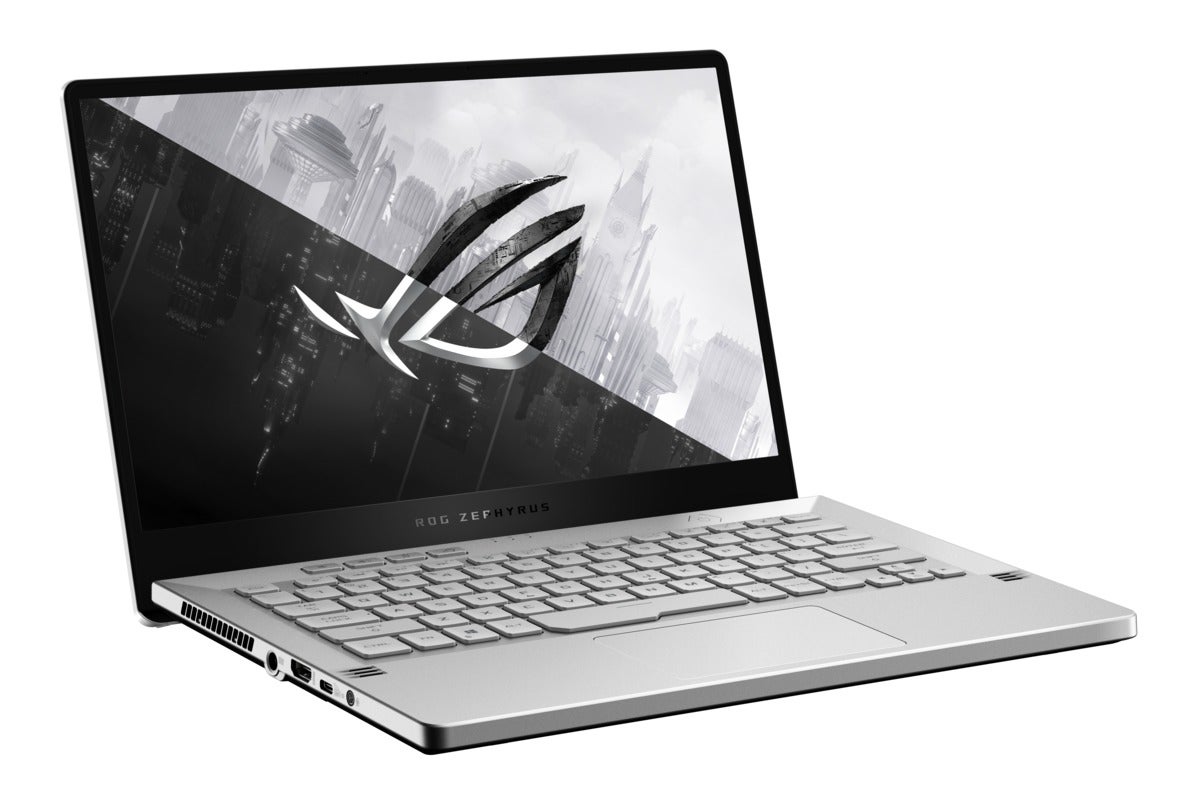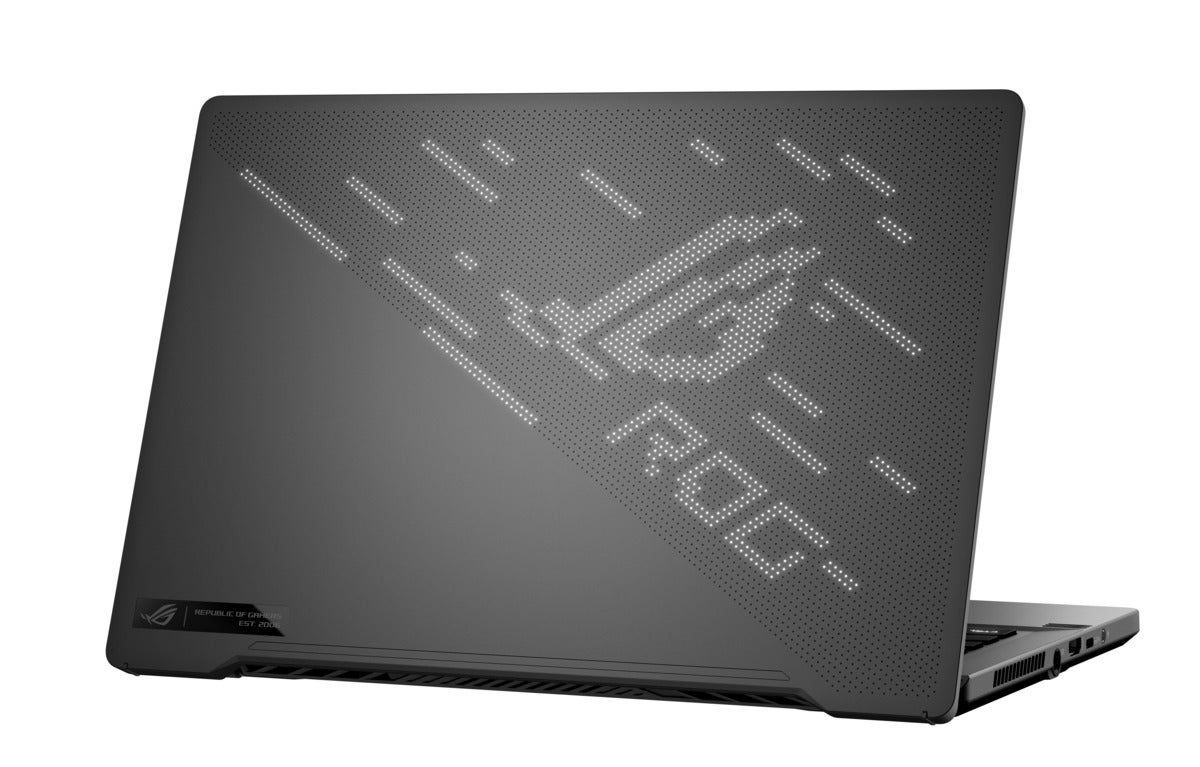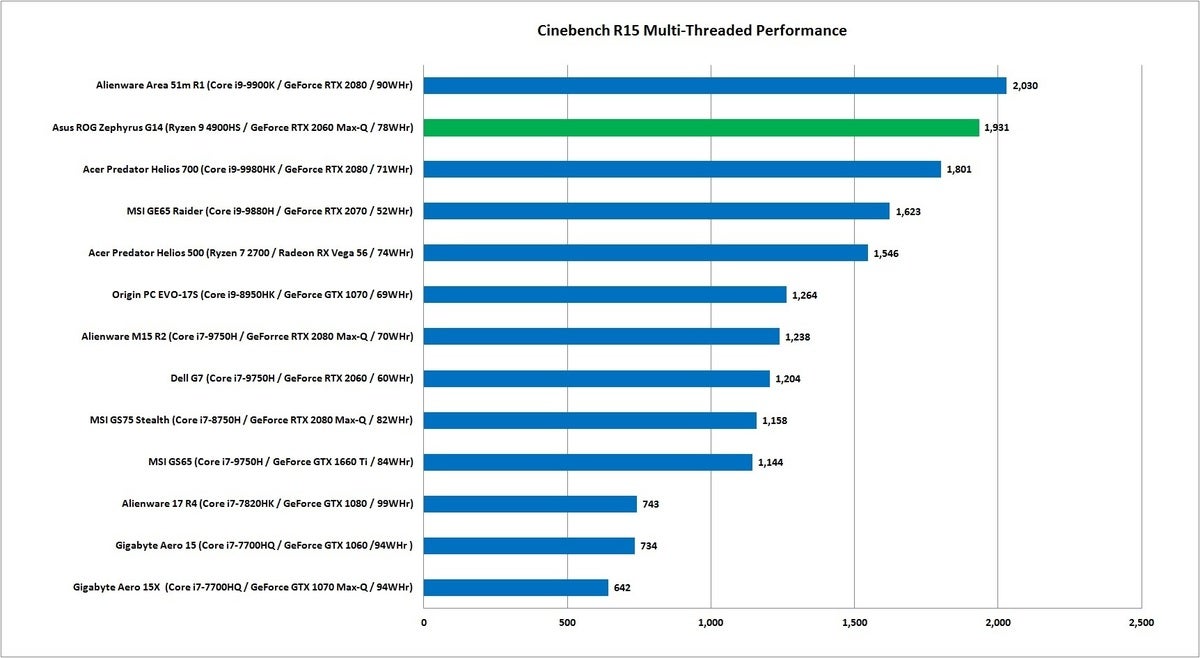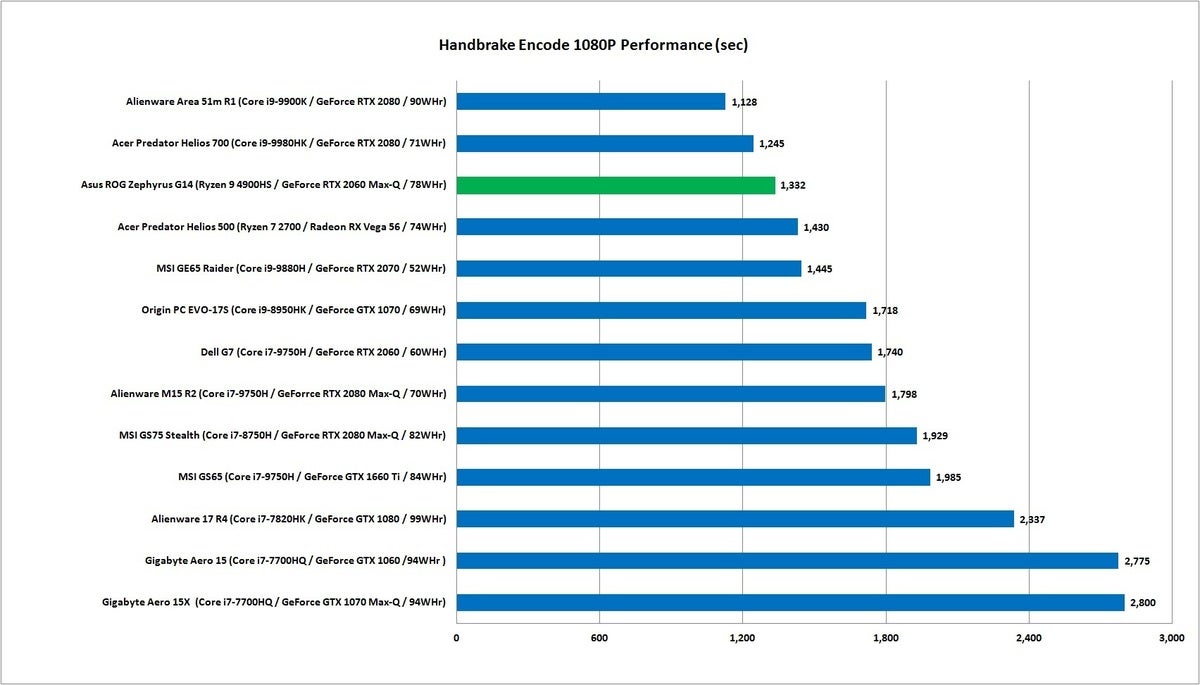 Credit: AMD
Credit: AMD
When AMD introduced its Ryzen 4000 mobile CPUs at CES, the company made bold claims of game-changing performance. Coming off of years of underwhelming laptop chips, AMD promised it had optimized Ryzen 4000 for mobile computing.
Now we’ve tested those claims in AMD’s Ryzen 9 4900HS chip, an 8-core, 7nm chip with Radeon Vega cores. We’re stunned at the CPU’s impressive tour de force that defeats just about every Intel 8th- and 9th-gen laptop CPU we’ve ever seen.
For this performance review, we’ll be looking at AMD’s Ryzen 9 4900HS chip. The ‘H’ means it’s intended for power users, and the ‘S’ means it’s for “slim”-profile laptops. Our testbed is the amazing Asus ROG Zephyrus G14 ($1,450 at Asus.com), a 14-inch laptop which also offers Nvidia’s new GeForce RTX 2060 Max-Q, 16GB of RAM, and a 512GB SSD. AMD promises about 100 more partner products in the near future. Keep reading to learn how this chip brings AMD back into the mobile game—and why Intel should be worried.
 Asus
Asus
The Asus ROG Zephyrus G14 features AMD’s new 8-core Ryzen 9 4000HS, as well as a GeForce RTX 2060 Max-Q GPU, in a mere 3.5-pound package.
How we tested
AMD’s Zen 2 core performance has been well-tested in desktops. The new element here is how performance will be affected by the limited thermals, power, and acoustics of the typical laptop.
Testing a mobile CPU is not at all like testing a desktop CPU. In a desktop, the reviewer can control what GPU, what SSD, what RAM, and what cooling is used, and test apples to apples or darn close to it.
Every laptop, on the other hand, is a custom-built platform. The closest anyone can get to apples-to-apples testing is on that rare occasion when the vendor offers two different CPUs in the same rig. For instance, we compared Intel vs. AMD CPUs in Acer’s Predator Helios 500, the sibling laptops being nearly identical otherwise.
When you test a laptop CPU, what little you can control are comparable size and weight. Larger and heavier laptops can typically offer more space for cooling and power. It’s not fair to compare it to a thin-and-light laptop, which will face more challenges with ventilation and likely throttle performance to keep things cooler.
 Asus
Asus
Asus AniMe Matrix version of the ROG Zephyrus G14 features a thousand LEDs on its lid that can scroll logos or even display GIFS.
For the most part we tested the Ryzen 9 4900HS in the laptop’s “turbo” setting, which is one click up from its default “performance” setting. For all of the other laptops, we selected the performance results, but did not include any actual overclocked scores for those laptops. While it’s true that the performance of a low-power, superlight gaming laptop won’t be all we can see from the chip, this is largely what AMD intended, as the Asus ROG Zephyrus G14 is the launch laptop for Ryzen 4000.
AMD actually wants you to see what a 3.5-pound laptop can do against 4.5-pound, 5-pound, and 7-pound laptops featuring Intel’s CPUs. The comparison laptops you’ll see are mostly in the ROG Zephyrus G14’s class, as well as ones far larger, and far heavier. We also include a laptop with an older 7th-gen quad-core, so you can see just how far we’ve come.
We should note that our comparisons mix mostly earlier test results with a few fresh numbers. Unlike our current desktop CPU reviews, where we keep the CPUs and can re-run tests with refreshed drivers, BIOSes, and OS, laptop tests are a snapshot in time before we return review units to the company. It’s not ideal, but when we’ve been able to retest, we’ve actually found little change. We’ll have fresher results once laptops with Intel’s newer 10th-gen chips show up.
Ryzen 4000 CPU performance
Our first test is Cinebench R15. It’s a 3D rendering benchmark made by Maxon based on the engine from its Cinema4D product, which features in such products as Adobe’s Premiere video editor. This is an older test (but still relevant), so we have a healthy list of comparable Intel-based laptops.
Like most 3D rendering engines, the test is heavily multi-threaded. The more CPU cores and threads you throw at it, the more performance you get. It runs on today’s laptops in under a minute, so the all-core boost speeds of each laptop will have a larger impact.
The results are nothing less than phenomenal for the Ryzen 9 4900HS. As you can see, it easily dispatches the 8-core Core i9-9980HK in the big Acer Predator Helios 700, as well as the 8-core Core i9-9880H in the MSI GE65 Raider. The old-school Ryzen 7 2700—a desktop chip—in the Acer Predator Helios 500 pulls up last among the 8-core CPUs. Intel’s Core i7 and its older Core i9 chips with “just” 6-cores can’t hang, either.
The reigning champion is neither surprising nor embarrassing for the Ryzen 9 4900HS. It’s the Alienware Area 51m R1, a true beast with a desktop Core i9-9900K at its heart.
Let that sink for a moment: A 3.5-pound Asus ROG Zephyrus G14 with a low-power Ryzen 9 4900HS is only about 5 percent slower than an 8.5-pound Alienware Area 51m R1 with a desktop Core i9-9900K. Granted, the Alienware could pull further away if overclocked, but this is a hell of a result for the Ryzen 9 4900HS.
 IDG
IDG
The low-power Ryzen 9 4900HS in the Zephyrus G14 easily dispatches every single Intel mobile CPU we’ve ever seen. Only the desktop Core i9-9900K in the Alienware Area 51m pulls ahead.
The song remains the same in Maxon’s new Cinebench R20, which uses a far more current engine from Cinema4D, supports up to 256 threads, and also stresses AVX, AVX2 and AVX512 workloads. Add in the much longer run times, and you have a benchmark that is particularly tough on CPUs that rely excessively on boost clocks.
You can see the results of the harsher workload below. The Ryzen 9 4900HS easily beats every single laptop Intel sells—from 10-pound hulks to 5-pound workhorses with 8 cores inside. The only dog higher in the pile is once again the Alienware Area 51m R1. That’s just wow.
 IDG
IDG
Cinebench R20 shows how a low-power Ryzen 9 4900HS can easily vanquish every single laptop CPU Intel sells today.
Multi-core performance is great, but the real world is often stuck in single-core land. While 3D modelling isn’t the same as say, running Microsoft Word, running Cinebench R15 on a single thread is still a valid way to measure how a CPU reacts under a given single-core load.
Intel’s mature 14nm CPUs have a well-known advantage in high clock speeds in the 4.8GHz to 5GHz range. Here, the Ryzen 9 4900HS falls back a few notches, but it loses only to three laptops that weigh 2.5 times as much as the ROG Zephyrus G14. Even with the thermal advantage, the Core i9-9980HK is only 3 percent ahead, and the mighty desktop Core i9-9900K, a mere 6 percent. The Ryzen 9 4900HS also pulls ahead of the only arguable competitor here, the Core i9-9880H in the MSI GE65 Raider.
 IDG
IDG
The Ryzen 9 4900HS in the 3.5-pound Asus ROG Zephyrus G14 loses—but the three that come in ahead weigh 2.5X as much and pack far more cooling.
We ran Cinebench R20 in single-threaded mode as well, and we were floored by the results. Although technically a tie, the Core i9-9880H and Ryzen 9 are dead even. With Intel’s clock speed advantage, especially in single-threaded tasks, we didn’t think it would be so close.
 IDG
IDG
The Ryzen 9 4900HS tied the Core i9-9880H in Cinebench R20.
For another perspective on CPU performance, we use the free HandBrake encoder to convert a 30GB, 1080p file using the Android Tablet preset. It’s a multi-core CPU test that can take an hour to run on a quad-core lightweight laptop. Even on the more powerful laptops being tested here, HandBrake conversion can take around 20 minutes. That’s enough time for most laptops to start to throttle down as the heat builds up around the busy CPU.
Only the laptops with the very best cooling can sustain higher clocks. At least, that’s the way it’s been with Intel’s 14nm chips. With the 7nm Ryzen 9 4900HS, you can apparently do well in this test simply by producing less heat. While the huge, thick Alienware Area 51m and Acer Predator Helios 700 come in first, right behind them is the 3.5-pound ROG Zephyrus G14. It’s a bit like having two muscle cars lay skid marks and tear away at a greenlight—only see the Nissan Leaf pulling up just behind them at the next light.
 IDG
IDG
It takes a desktop Core i9 and 10-pound chassis to beat a 3.5-pound laptop with AMD’s Ryzen 9 4900HS in it.
Keep reading to see Ryzen 4000 gaming performance.

















